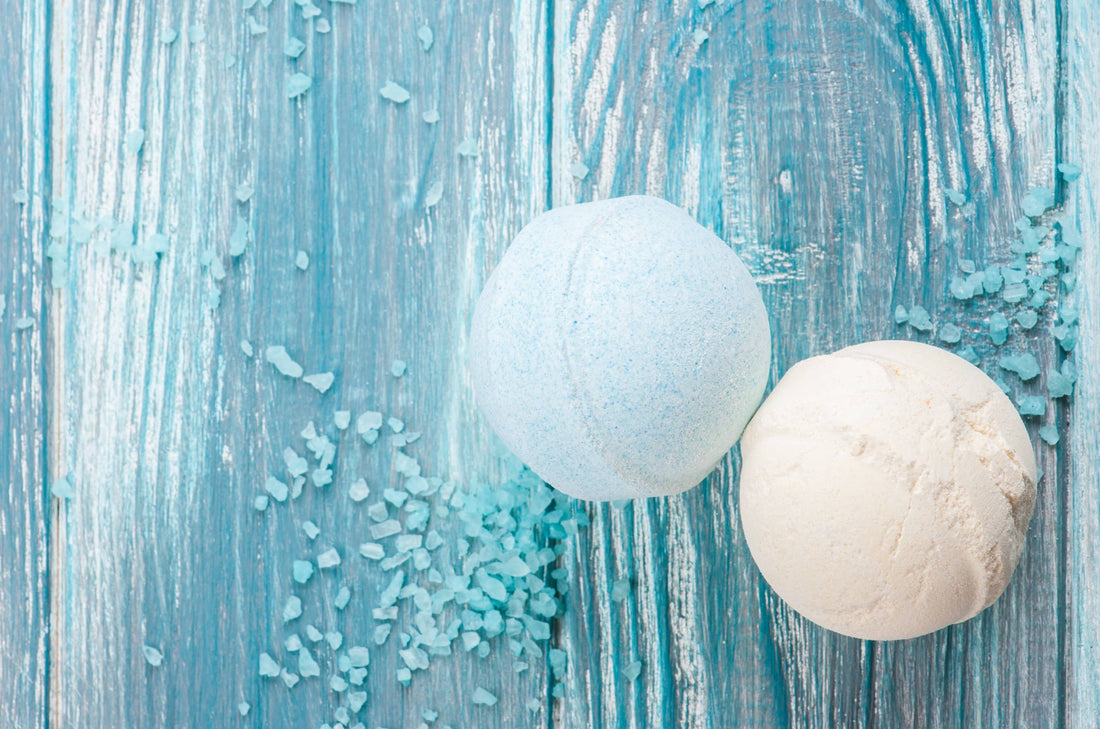While bath bombs are trendy and fun, many contain harsh chemicals that can cause skin irritation, disrupt hormones, and even lead to vaginal infections. Ingredients like artificial dyes, synthetic fragrances, parabens, and phthalates are common culprits behind allergic reactions and inflammation. Fortunately, there are safer, natural alternatives like Epsom salt, oatmeal baths, and milk baths made from shredded goat milk soap. These offer relaxation without harmful side effects, making them a healthier choice for sensitive skin and overall wellness.
Ever since they “exploded” on the scene, bath bombs have been everywhere — grocery store aisles, influencer Instagram accounts, and, more than likely, your own bathroom. There’s a lot to love about bath bombs, as they can elevate bath time from lowly to luxe. But as it turns out, there’s a lot more to bath bombs than just fizzy fun in the tub.
The effects of using bath bombs are terrifying and big brands are simply not telling you the truth.
Are Bath Bombs Really Dangerous?
It’s important to note that not all bath bombs are made the same, and their ingredient lists can vary as widely as the companies that manufacture them. Still, it’s safe to say that, regarding conventionally made bath bombs, there are some common characteristics that make their safety questionable.
Here’s a look at the most common bath bomb dangers:
Danger #1 - Skin Irritation
It’s the things that people love most about bath bombs — the cool colors and intoxicating fragrances — that typically wreak the most havoc on skin.
For starters, artificial dyes like FD&C Yellow #5 and Red #4 that are used to make bath bombs are known allergens. Also known as tartrazine, Yellow #5 can cause hives and rashes, while Red #4, also known as carmine, can trigger allergic contact dermatitis.
Meanwhile, because the FDA doesn’t require cosmetic manufacturers to list the specific ingredients that are used to create “fragrance,” that blanket term may be hiding a host of other scary ingredients. Researchers found that known allergens in fragrances were found in up to 100% of cosmetic products (a category that includes bath bombs). People with pre-existing skin issues, like eczema, are more likely to react to them, and the reactions to these ingredients can be quite scary.
One UK mother even rushed her daughter to the hospital after that child broke out in a rash so bad that her mom feared it was a case of meningitis.
Another mother in the US posted pictures of her daughter on Facebook, noting that the redness and inflammation on her skin after using a bath bomb looked like a chemical burn. While dermatologists noted that a chemical burn from bath bombs was unlikely, they did acknowledge that the child had likely experienced an “irritant dermatitis,” or skin irritation, caused by the bath bomb ingredients. Do a search online and you'll find this mother is not alone. In fact, we've heard from many of our own customers who've also said painful rashes appeared after using a bath bomb.
Danger # 2 - Vaginal Irritation & Vaginal Infection
If common bath bomb ingredients can cause that kind of irritation to normal skin, imagine the kind of damage they can do to more sensitive areas of the body, like the vagina.
In an interview with SELF Magazine, Jessica Shepherd, MD, Director of Minimally Invasive Gynecology at the University of Illinois at Chicago, noted that the chemicals in bath bombs can alter the vagina’s pH level, causing it to become irritated or itchy. This alteration can also lead to changes in vaginal discharge.
What’s more, continued use of bath bombs can shift the vagina's pH so much that it triggers a yeast infection. There are 10 to 20 strains of bacteria that keep the vagina healthy, and when this perfect balance is thrown off—killing off the good bacteria and letting the bad bacteria, or yeast, grow unchecked—an infection may not be far behind.
Danger #3 - Hormone Disruption
In addition to irritating the skin and triggering vaginal irritation and/or yeast infections, some questionable ingredients on bath bombs are also known to disrupt the body’s delicate hormonal balance.
Phthalates are a group of chemicals that are used in personal care products as a solvent and fixative in fragrances, and, according to animal studies, these chemicals can damage the liver, kidneys, lungs, and reproductive system, including the still-developing testes of male babies in utero.
That's not the only thing that can disrupt hormones. If allowed to travel through the vagina, uterus, and fallopian tubes to the ovary (which is entirely possible with bath bomb use), talc (or talcum powder may cause ovarian cancer.
And parabens, a group of chemical preservatives designed to keep cosmetic products from spoiling, can “act like the hormone estrogen in the body and disrupt the normal function of hormone systems,” according to the Environmental Working Group.

Natural Alternatives to Bath Bombs
Now, ditching bath bombs doesn’t mean that you have to forgo baths altogether. Below are a few alternatives to the fizzy orbs that are sure to make your bath just as enjoyable—and also much, much safer.
Epsom Salt Baths
If you’re looking to relax sore muscles, an Epsom salt bath is a surefire remedy that has been used for hundreds of years. It’s the naturally occurring magnesium sulfate in the salt that can loosen tight muscles and even reduce skin irritation (unlike those pesky bath bombs).
Oatmeal Baths
Oatmeal baths have long been used to soothe irritated skin and calm flare-ups from rashes or allergic reactions. In fact, we tried giving our son, Chance, oatmeal baths to help soothe the eczema that was causing him intense pain and itching. The oatmeal worked temporarily, but we also found that it was a hassle and extremely messy to clean up afterward.
The ULTIMATE Alternative: Milk Baths
Milk baths are — hands down — the best all-natural alternative to bath bombs. It’s said that Cleopatra, who was revered for her beautiful skin, would regularly soak in goat milk to keep her skin looking young and fresh. Who needs bath bombs when you can soak in fresh goat milk?!
Made by shredded bars of our goat milk soap, add 1-2 handfuls of this product to your own bathtub to recreate a spa-like experience of a milk bath in the comfort of your own home. And because we use only safe, non-toxic, skin-loving ingredients, you can trust that with every dip in the tub, your skin will look and feel better with each soak. These ingredients offer your skin the nutrients, moisture, and tender loving care it needs to perform at its best.
Available in 15 unique scents that cater to everyone from the essential oil lover to those with sensitive skin, we love blending different milk bath scents together to create the ultimate bathtime experience.
TIP💡 Almost every scent goes well with Oatmeal & Honey Milk Bath (which is the most emollient of all!) but you can check out all of our milk bath combinations here.
Back to You
While bath bombs are incredibly popular right now, they’re definitely not the best way to enjoy a relaxing bath. Instead, opt for our fan-favorite milk bath product. Milk baths make it super easy to slip into a soothing soak that will actually nourish your skin from the inside out and make it look (and feel) like a million bucks. And if you’re looking for fun scents, try our essential oil milk baths in scents like English Garden and Lavender Blossom. We promise you won’t miss the bath bombs!
Related Posts to Enjoy
- Blog Post: The Benefits of Milk Baths You Need to Know
- Blog Post: 8 Reasons to Choose Oatmeal & Honey Milk Bath
- Blog Post: Fix Natural Deodorant Rash
- Blog Post: How to Get Soft Feet in Minutes
- Blog Post: The Top 5 Ingredients to Avoid in Soap
Frequently Asked Questions
Are bath bombs bad for your skin?
Yes, many commercial bath bombs contain artificial dyes and fragrances that can trigger allergic reactions, rashes, or skin irritation — especially for people with eczema or sensitive skin.
Can bath bombs cause vaginal infections?
Yes. Chemicals in bath bombs can disrupt the vagina’s pH balance, leading to irritation, itching, or even yeast infections due to bacterial imbalance.
Do bath bombs affect hormones?
Potentially. Ingredients like parabens and phthalates found in some bath bombs can act as endocrine disruptors, mimicking estrogen and interfering with hormonal function.
What’s the safest alternative to bath bombs?
Milk baths made from shredded goat milk soap are one of the safest and most luxurious alternatives. They hydrate, soothe, and nourish the skin without harmful additives.
Is it safe to bathe in essential oils or Epsom salt instead?
Yes, Epsom salt and essential oil blends (when properly diluted) are generally safe and effective for muscle relaxation and skincare, especially when free of synthetic ingredients.





4 comments
Do you have any shampoo products ?
I only used a bath bomb one time, my skin was so itchy that I never used them again. Now I toss in the milk bath and love love soaking in the bath and having soft feeling skin and no itchiness.
Are all your products made entirely in the USA ?
For as long as I can remember I have had rough, dry and extremely itchy skin around my ankles and calfs. It would get so bad that I would scratch in my sleep and nothing I tried helped until I discovered your Oatmeal Soap and I no longer have any problems with my legs, no itch, no scabs from night scratching and no irritation from my socks. Thanks for a wonderful product!